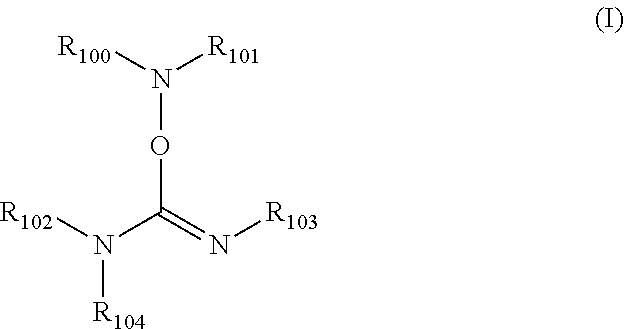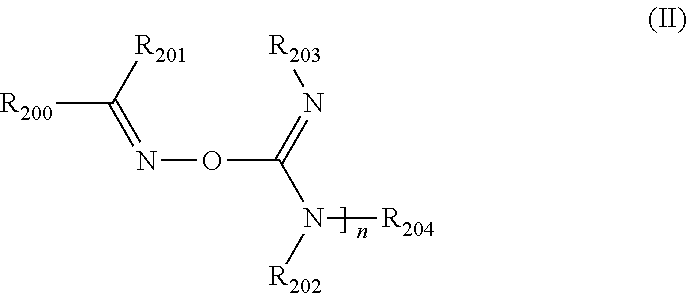Polymerizable compositions containing ethylenically unsaturated monomers having episulfide functional groups and related methods
a polymerizable composition and functional group technology, applied in the field of polymerizable compositions, can solve the problems of peroxide ignitability, polymerization initiators that are conventionally used in such compositions can have safety risks associated, and yellowing is often a problem, so as to reduce the yellowness index of sulfur-containing polymeriza
- Summary
- Abstract
- Description
- Claims
- Application Information
AI Technical Summary
Benefits of technology
Problems solved by technology
Method used
Image
Examples
example 1
Step A
[0058]Into a 50 mL round-bottom flask under N2 was added cyclohexanone oxime (2.87 g, 25.3 mmol) and tetrahydrofuran (THF) (15 mL). The round bottom of the flask was submersed in a room temperature water bath to modulate any exotherm (however, none was observed), and diisopropylcarbodiimide (3.8 g, 30.1 mmol) was added, followed immediately by ground NaOH (0.1 g, 2.5 mmol). The resulting solution was stirred for 6 hours in the room temperature water bath using a magnetic stirrer, becoming turbid at some point. The mixture was filtered using a Buchner funnel and Whatman #4 filter paper. After cooling the resulting mixture to 4° C., it was filtered and concentrated under reduced pressure to yield a light yellow solid (3.27 g). NMR showed that the product had a structure consistent with 1,3-diisopropyl-O—(N-cyclohexylideneamino)-isourea.
Step B
[0059]Into a 20 mL glass scintillation vial was added 100 parts by weight of thioglycidyl methacrylate which was filtered through a 0.45 μm...
example 2
[0061]The procedure from Step B of Example 1 was followed except that 1 part of tetrabutylphosphonium bromide was used in place of 1 part of N-methylimidazole and 1.5 parts of 1,3-diisopropyl-O—(N-cyclohexylideneamino)-isourea was used in place of 1.0 part.
example 3
[0063]The procedure from Step B of Example 1 was followed except that the following was used: 90 parts of filtered thioglycidyl methacrylate, 10 parts of bis-(β-epithiopropyl)sulfide, 1 part of boron trifluoride diethyl etherate and 1 part of 1,3-diisopropyl-O—(N-cyclohexylideneamino)-isourea.
PUM
| Property | Measurement | Unit |
|---|---|---|
| refractive index | aaaaa | aaaaa |
| refractive indices | aaaaa | aaaaa |
| temperature | aaaaa | aaaaa |
Abstract
Description
Claims
Application Information
 Login to View More
Login to View More - R&D
- Intellectual Property
- Life Sciences
- Materials
- Tech Scout
- Unparalleled Data Quality
- Higher Quality Content
- 60% Fewer Hallucinations
Browse by: Latest US Patents, China's latest patents, Technical Efficacy Thesaurus, Application Domain, Technology Topic, Popular Technical Reports.
© 2025 PatSnap. All rights reserved.Legal|Privacy policy|Modern Slavery Act Transparency Statement|Sitemap|About US| Contact US: help@patsnap.com


